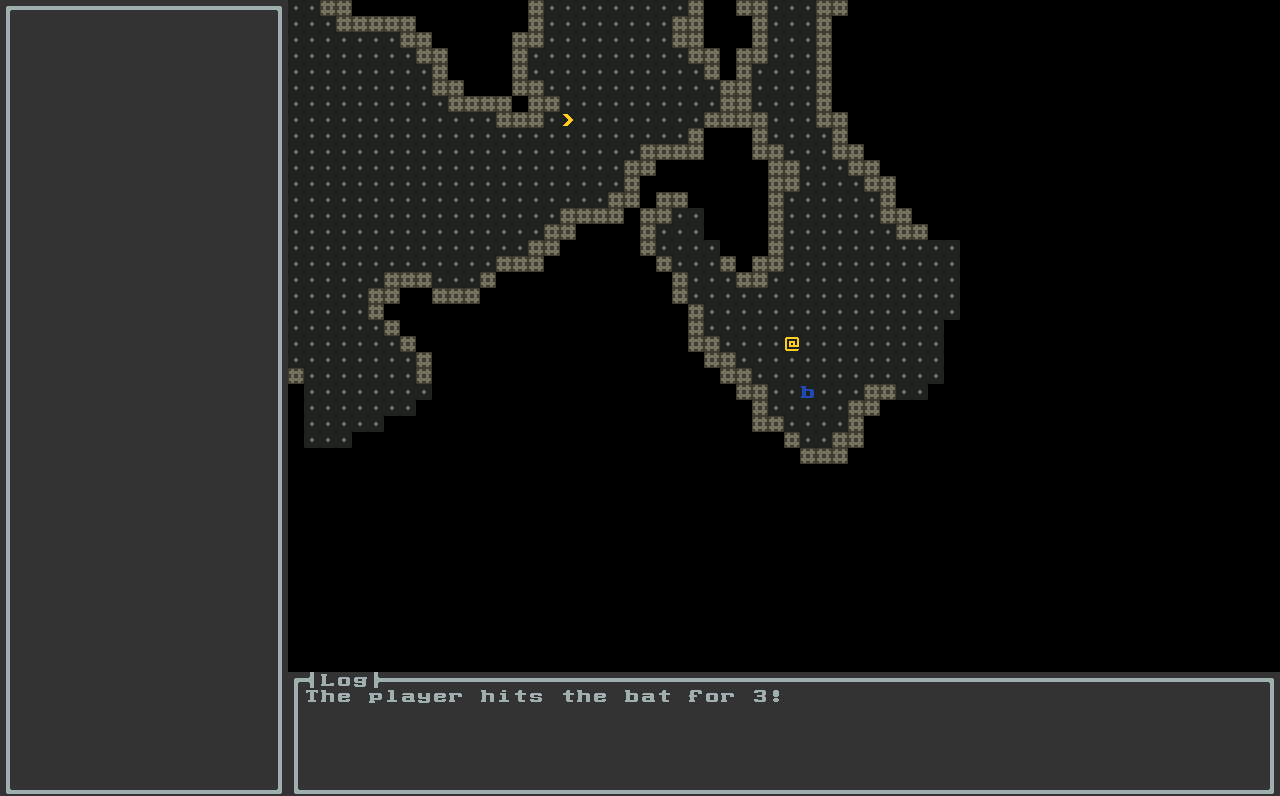This article is part of a series.
Prev: «How To Make a Roguelike: #10 Vision and Fog of War Next: How To Make a Roguelike: #12 Items and Inventory »
Now that we have Fog of War in place which we can reveal let’s make it a bit more exciting by adding some wandering monsters into the mix that can jump on us…or rather bump into us! This will also be the first instance of real combat: it won’t be just beating things to a pulp like we did with fungi, because these creatures will hit back!
⚠️ Bug report: You might have noticed that if you’re pressing the keys too fast the game spits out concurrent modification exceptions or other weird things. This was caused by a bug in Amethyst. Fortunately you can upgrade Amethyst to a new version that fixes this problem. Modify
gradle.propertiesand setamethyst_versionto2021.0.1-RELEASE.
A Wild Bat Appears
So let’s think a bit about what we want to add. It should be something really simple which is easy to code and will serve as a good first example. One of the most likely cave dwellers is a bat so let’s add one to our game!
A bat is a very simple creature, it has a few hit points, it doesn’t bite hard and it just flies around randomly. Let’s see how we can implement it.
First of all, let’s add a new color for our bat to GameColors:
val BAT_COLOR = TileColor.fromString("#2348b2")
and this to GameTileRepository:
val BAT = Tile.newBuilder()
.withCharacter('b')
.withBackgroundColor(GameColors.FLOOR_BACKGROUND)
.withForegroundColor(GameColors.BAT_COLOR)
.buildCharacterTile()
We also need a new EntityType so let’s add this to EntityTypes.kt:
object Bat : BaseEntityType(
name = "bat"
), Combatant
We’re all set!
The Wanderer Behavior
With the plumbing in place now we can define a new behavior which we can call Wanderer. What this Behavior will do is it moves the entity around picking a random neighboring position. Simple enough, right? Let’s see:
package com.example.cavesofzircon.systems
import com.example.cavesofzircon.extensions.position
import com.example.cavesofzircon.extensions.sameLevelNeighborsShuffled
import com.example.cavesofzircon.messages.MoveTo
import com.example.cavesofzircon.world.GameContext
import org.hexworks.amethyst.api.base.BaseBehavior
import org.hexworks.amethyst.api.entity.Entity
import org.hexworks.amethyst.api.entity.EntityType
object Wanderer : BaseBehavior<GameContext>() {
override suspend fun update(entity: Entity<EntityType, GameContext>, context: GameContext): Boolean {
val pos = entity.position
if (pos.isUnknown.not()) { // 1
entity.receiveMessage( // 2
MoveTo(
context = context,
source = entity,
position = pos.sameLevelNeighborsShuffled().first() // 3
)
)
return true
}
return false
}
}
Here we:
- Check whether the
Entityhas a validPosition - If yes, we send it the
MoveTocommand - Using a random neighboring position
Simple enough!
You might be wondering why don’t we just move the bat by hand. Why do we send a command to itself? The answer is that it might be possible that a bat has some state which prevents it from moving like being frozen or asleep! In this case the
Movablefacet might not even be present on the bat! By using commands we delegate all these problems to whatever system handles it thus keeping the separation of concerns and our code clean.
Now with our new Wanderer system in place we can finally create a bat Entity:
// add these to EntityFactory
import com.example.cavesofzircon.attributes.types.Bat
import com.example.cavesofzircon.systems.Wanderer
fun newBat() = newGameEntityOfType(Bat) {
attributes(
BlockOccupier, // 1
EntityPosition(),
EntityTile(GameTileRepository.BAT),
CombatStats.create( // 2
maxHp = 5,
attackValue = 2,
defenseValue = 1
),
EntityActions(Attack::class) // 3
)
facets(Movable, Attackable, Destructible) // 4
behaviors(Wanderer) // 5
}
So the definition of a bat is:
- It occupies a block so we can’t move to the same tile as a bat
- It has the usual attributes, but not too much hp/attack/defense
- It can only attack (no digging sorry)
- It can be moved, attacked and destroyed
- And it will wander on its own
Now to make this work we just need to add bats to our world. This goes to GameConfig
const val BATS_PER_LEVEL = 10
and these ones go to GameBuilder:
// new imports
import com.example.cavesofzircon.GameConfig.BATS_PER_LEVEL
// add this to buildGame
fun buildGame(): Game {
// ...
addFungi()
addBats()
// ...
}
// and this to GameBuilder
private fun addBats() = also {
repeat(world.actualSize().zLength) { level ->
repeat(BATS_PER_LEVEL) {
EntityFactory.newBat().addToWorld(level)
}
}
}
Now if we start the game we’ll notice that the bat can move to the same tile as the player and it can’t hit us either! Why is that? Well, we didn’t make the player Attackable, Destroyable and it is not a BlockOccupier! Let’s fix this:
fun newPlayer() = newGameEntityOfType(Player) {
attributes(
Vision(9),
EntityPosition(),
BlockOccupier,
CombatStats.create(
maxHp = 100,
attackValue = 10,
defenseValue = 5
),
EntityTile(GameTileRepository.PLAYER),
EntityActions(Dig::class, Attack::class)
)
behaviors(InputReceiver)
facets(Movable, CameraMover, StairClimber, StairDescender, Attackable, Destructible)
}
Now if we start the game everything fits together nicely:

Now this is much more interactive than stomping fungi!
Conclusion
As you can see with all the Systems and Attributes we have we can really start to be productive because the code we’ve written in the previous articles are reusable and cohesive. Here we reused Movable, Attackable, Destructible, and also the EntityActions to produce a completely new entity with only a little coding on our part.
Next we’re going to take this to the next level by adding items and inventory to our game!
Until then go forth and kode on!
The code of this article can be found in commit #11.
Do you have questions? Ask us on our Discord Server.
If you like what we do and want to support us consider becoming a Patron.